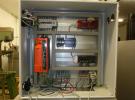Dear Labjack,
I am trying to implement differential inputs through DG409 multiplexer(4:2) rather than the single ended 8:1 DG408 used for the mux80 board. This is so that i can use one instrumentation amplification stage and filtration stage after the multiplexing stage like the attached diagram.
Could you please assist us to tell us if the attached architecture is feasible. If so could you please assist us on how we can establish a code/script to control the DG409 to have the above application. We seem to be struggling with this as we only used the MUX80 board and call the already built-in registers AIN0 to AIN109(66 channels) in order to get multiplexing. But i do not understand how to do the same for the current architecture. your advice and help is greatly appreciated here.



.png%3Fitok=PHGBxf6M)


.jpg%3Fitok=B1YcuDFK)
.png%3Fitok=Ybt-OlgU)
No attachment came through. Please try again.
I actually have been talking with someone over email about a similar application and this is what I suggested:
Does that sound like what you are thinking?
For others reading this, note that you can do differential inputs on our normal Mux80, but not 64 pairs and with the 42 differential pairs you do get with the Mux80 some are split across different DB37 connectors.
Hi Labjack support team,
sorry about the missing attachment. This time its attached.
What i would like to do is to insert 66 analog channels through differential pairs. the output is connected to an in-amp and followed by a filtration stage. Which makes the design as differential input before multiplexing. and then single ended inputs after multiplexing. for 66 channels this would mean 17 multiplexers to be fed into 17 analog inputs. but since we have only 14 analog inputs, this task seems to be a bit confusing. to integrate to. Is there a way to accomplish this using the labjack?
So you mean 66 differential pairs right? 132 analog signal wires?
I suggest 20x DG409 to switch 80 differential pairs to 20 differential pairs. You need just 2 DIO lines to control those 20x muxes.
That leaves you with 40 analog signals, so you need another layer of muxes. Use another 5x DG409 muxes to switch the 20 remaining differential pairs down to 5 differential pairs, and those 5 differential pairs connect to AIN4-AIN13. So that would require another 2 DIO lines.
So you would need a custom channel mapping that controls 4 DIO lines and then acquires a reading from the proper differential channel: AIN4/5, AIN6/7, AIN8/9, AIN10/11 or AIN12/13.
If that all sounds good, we can help you come up with a channel number scheme to do this.
Dear Labjack team,
The only thing that is missing is that the differential pairs are fed to an instrumentation amplifier which then makes it a single ended input again. Could you take a look at the previously attached schema. That means the labjack takes in again a single ended input. We are taking single ended inputs from differential pairs.
Sounds like you actually need 2 more layers of muxes. You need 2x DG409 that mux the 5 differential pairs down to 2 differential pairs, and then 1 more DG409 that muxes the 2 differential pairs down to 1 that then connects to your in-amp. So you will need to control 8 digital outputs to control the 28 muxes, and then read 1 single-ended analog input.
Dear Labjack,
Seems close to what we are trying to implement. Could you please help us in designing a structure and channel mapping code inorder to make this work. And perhaps to be able to split the 66 channels to use all the 14 analog inputs so as to not put a strain on individual inputs?
Using an analog input does not cause any kind of strain or wear on it, so don't be concerned about only using 1 analog input for everything.
If you only want to use 1 in-amp, then you use the 28 muxes & 8 DO as described previously with only 1 AIN.
If you use 2 in-amps and 2 AINs, you drop to needing 27 muxes & 6 DO.
If you use 5 in-amps and 5 AINs, you drop to needing 25 muxes & 4 DO.